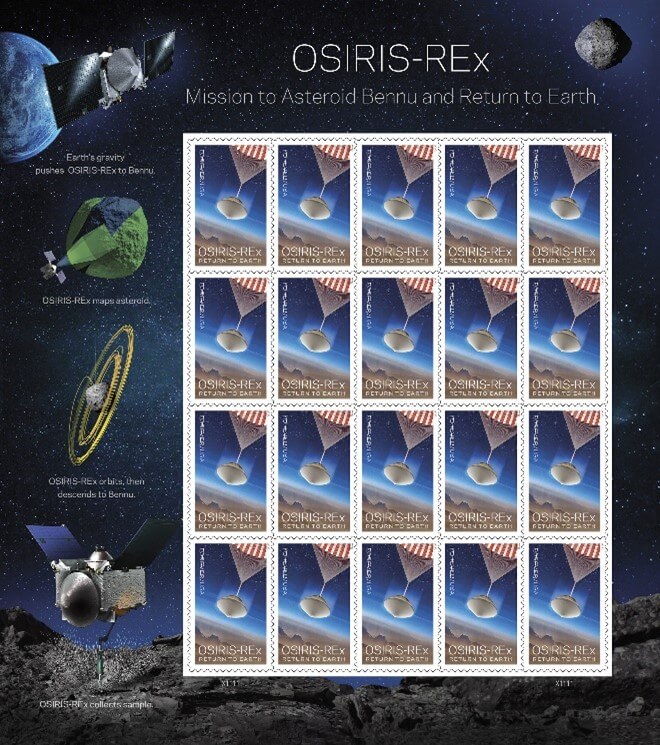
SALT LAKE CITY — The U.S. Postal Service today celebrated the imminent arrival of samples of the asteroid Bennu from NASA’s OSIRIS-REx mission by releasing a stamp in a dedication ceremony at the Clark Planetarium.
While dedicating the stamp, Robert Raines, the Postal Service’s business solutions vice president, said, “I think we would all agree that this mission exemplifies the best of American innovation. That’s why the Postal Service is proud to recognize it — and to add OSIRIS-REx to the long list of U.S. stamps honoring remarkable achievements in ingenuity, perseverance and teamwork.”
Mike Puzio, now an engineering student at North Carolina State University, was in third grade in 2013 when he won a contest to name the asteroid. He said about his involvement with the mission, “It feels surreal just thinking about it. Opportunities from OSIRIS-REx have changed my life, and remembering that I am a known part of that baffles me sometimes.”
“OSIRIS-REx will give us amazing insights into the formation and early evolution of the solar system, in particular, we anticipate the samples will provide new information about the kinds of materials that made up our infant Earth,” said Lori Glaze, director of NASA’s Planetary Science Division at the agency’s Headquarters in Washington. “We are exceptionally pleased that the Postal Service will commemorate this journey of exploration and help NASA share the excitement of discovery with the public.”
OSIRIS-REx is an acronym for the mission’s goals: Origins, Spectral Interpretation, Resource Identification, and Security-Regolith Explorer. More simply, “Origins” refers to the study of the pristine carbon-rich material the spacecraft collected. “Spectral Interpretation” means measuring the composition of the asteroid. “Resource Identification” is assessing potential fuel, oxygen, water and minerals on the asteroid. “Security” relates to scientists’ calculating the odds of Bennu colliding with Earth. The final part of the mission’s name, REx, is short for “Regolith Explorer,” and it refers to studying the regolith — or layer of loose material on the asteroid’s surface.
OSIRIS-REx, which is the size of a large passenger van, left Earth aboard a rocket launched from Cape Canaveral, FL, on Sept. 8, 2016. Once released from the rocket, it orbited the sun for a year until it passed by Earth again. At that point, our planet’s gravity helped propel the spacecraft toward Bennu. After OSIRIS-REx arrived in the asteroid’s orbit, in December 2018, it got to work. With its special cameras and spectrometers, it began photographing and mapping Bennu’s surface to determine the best site from which to collect samples. Scientists were surprised to learn, from the photographs the spacecraft sent back, that the asteroid’s surface was much different from what they had expected. Instead of being relatively smooth, it was rocky and cratered, so finding a sample-collection site posed challenges. Eventually they chose a site about the size of a tennis court, located in a crater.
The time for the rendezvous arrived in October 2020. To carry out its task, the spacecraft did not actually land on the asteroid but instead slowly descended toward the surface and extended a robotic arm. A collection device at the hand-end of the arm then released a sudden puff of nitrogen gas that sent up a cloud of dust and rocks from Bennu’s surface. NASA estimates about 8.8 ounces of these materials were captured in a special container in the collection device, which then closed and retracted into the spacecraft. Even though this seems like a miniscule amount, considering the effort involved, it’s the largest sample ever collected from an asteroid, and the first such collection by the United States.
On May 10, 2021, OSIRIS-REx began its flight back toward Earth. Its container of asteroid dust and rocks, enclosed in a special capsule, will parachute onto the Utah desert on Sept. 24, 2023.
The OSIRIS-REx mission — a collaboration among NASA, the University of Arizona, and Lockheed Martin — exemplifies American ingenuity, perseverance and teamwork.
To learn more about the mission, visit www.nasa.gov/osirisrex.
The stamp artwork shows the capsule containing the sample parachuting to the Utah Test and Training Range, a U.S. Department of Defense facility. A depiction of Bennu’s surface appears at the bottom of the pane’s selvage, with outer space above — deep blue and dappled with celestial bodies. A view of the asteroid is in the upper right corner.
Along the left side of the pane are four images that illustrate crucial milestones. The top image shows OSIRIS-REx one year into the mission, passing 11,000 miles over Antarctica, as Earth’s gravity boosts the spacecraft toward Bennu. The second image represents OSIRIS-REx conducting its two-year global mapping campaign of Bennu, searching for the best location to collect a sample. The third image shows the spacecraft’s orbit in yellow and its path to the asteroid in white. In the fourth image, OSIRIS-REx extends its robotic arm to Bennu’s surface to capture a sample. On the reverse side of the pane is text courtesy of NASA that describes the OSIRIS-REx mission and explains each image.
Alan Dingman illustrated the stamp and pane, basing his work on images supplied by NASA. Antonio Alcalá, an art director for USPS, designed the stamp and pane.
OSIRIS-REx is issued as a pane of 20 Forever stamps, which will always be equal in value to the current First-Class Mail 1‑ounce price. News of the release is being shared with the hashtag #OSIRISRExStamp.
